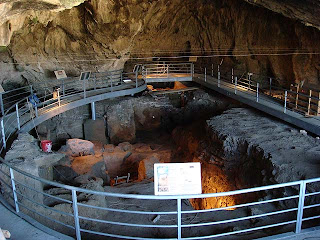As my friends know, I love old walls. So I was very excited to hear the announcement by the Greek Ministry of Culture on Monday 22nd March that a 23,000 year old wall had been discovered in Thessaly.
Paleoanthropologist Dr. N. Kiparissi has been excavating in the cave of Theopetra near Kalambaka for the past 25 years (another life’s work – see my blog 2 March) and amongst other discoveries revealed the remains of a wall (below) which had apparently been built to partially block the entrance to the cave.
The wall was built to restrict the entrance to the cave by two-thirds, and this suggests that its purpose was to protect the inhabitants from the cold, given that the wall’s age matches the coldest period of the most recent ice age. The wall was dated by optical luminescence, a method which determines how long ago mineral grains were last exposed to daylight, and the result means that this is the oldest man made wall in Greece and probably one of the oldest in the world.
The cave can be found near Kalambaka, the town usually more associated with the monasteries of Meteora in Thessaly, Greece.
Paleoanthropologist Dr. N. Kiparissi has been excavating in the cave of Theopetra near Kalambaka for the past 25 years (another life’s work – see my blog 2 March) and amongst other discoveries revealed the remains of a wall (below) which had apparently been built to partially block the entrance to the cave.
The wall was built to restrict the entrance to the cave by two-thirds, and this suggests that its purpose was to protect the inhabitants from the cold, given that the wall’s age matches the coldest period of the most recent ice age. The wall was dated by optical luminescence, a method which determines how long ago mineral grains were last exposed to daylight, and the result means that this is the oldest man made wall in Greece and probably one of the oldest in the world.
The cave can be found near Kalambaka, the town usually more associated with the monasteries of Meteora in Thessaly, Greece.


Comments
Post a Comment